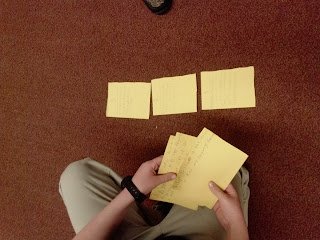Rigor. What a beautifully complex word. A word, a concept, that often eludes me in my curriculum planning. Long work commutes have been spent manipulating math problems in my head...and then jotting them down at stop lights. On scraps of paper. Or on my hand. By the glow of my car's dome light. Something was telling me this wasn't working...maybe it was the guy in the car behind me, waiting for me to notice the light had turned green.
But what to do instead?? Lately I've had Yeap Ban Har's words running through my mind. Advice I heard at a Singapore Math conference two years ago (or 14 in teacher years, which are like dog years). Let them struggle, he said. Get the most out of our problem and use it for days.
Now the practical side of me thought this Yeap guy must be truly disconnected from the classroom if he thought one math problem could last my kids a whole week, even with "math discussion". The other side of me, the one that wants to have a life outside of school, hoped he was wise beyond my own understanding and it really was possible.
So I flipped open my dog-eared copy of this book and began rereading my old highlights. SO MUCH GOOD STUFF.
First of all, it discuss and compares the results of the TIMSS report, that beast of an international study that helped determine, through video and data, why Japan is a top performer in math and the U.S. is...well, not. One of the most fascinating things to me was the comparison of lessons structure between the U.S., Germany and Japan. They even showed it in an easy-to-read-quickly chart, which I much appreciated (I've become a bullet point kind of girl). The break down is essentially this - in bullet point format: (one specific lesson that summarizes the general)
Germany
- 15 min: having students work difficult problems on the board from the previous night's homework
- 20 min: Teacher presents problem for day-theorem students have to prove-teacher leads through process
- 10 min: Theorem reviewed by reading aloud from handout
Japan
- 5 min: review previous day's lesson & assign problem not finished
- 5 min: Students present solution methods
- 15 min: Teacher presents day's task for students to work on solving independently
- 20 min: Students continue their work in small groups, discuss solution methods
- 5 min: Teacher show good method for solving
U.S.
- 8 min: Teacher asks short-answer review questions
- 5 min: Homework checked by teacher calling on students for answers
- 15 min: Worksheet given with similar problems; students work independently, teacher monitors, notices confusions & demonstrates solutions
- 15 min: Teacher review of another worksheet & demonstration solving of challenging problems
- 5 min: Quick oral review of problems similar to ones worked that day
- 10 min: Students finish worksheets & assigns homework
So fascinating, right?? What did you notice? Time lengths, surprising. Depth of content, shocking. Difference between a U.S. math lesson structure and a Japanese one? Not surprising at all. This comparison is why I decided last year to take a risk, trust my students and completely change the structure of my math time. More on that soon...










